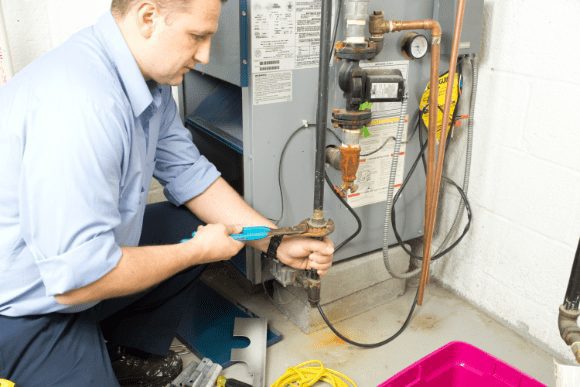A few years ago, most furnaces relied on standing pilot lights to work. A standing pilot light is a small gas flame that’s always ignited. This often has a green light bulb placed in front of it, so is seen as a green flicker from the outside of the furnace.
The problem with standing pilot lights is that not only can they be unreliable, but they also waste a lot of energy as they’re constantly burning gas. Because of this, electronic ignition systems have now started to replace standing pilot lights. While, for the most part, these are considered to be a good replacement, the issue occurs when the electronic ignition system fails. Meaning that no gas is able to enter the burner, and so, the furnace is unable to light.
Let’s set the scene. You’ve noticed that the weather’s getting a little chilly outside, so decide to set your home’s heating to timer mode. However, when you attempt to switch on your heating, you notice that your furnace ignitor isn’t igniting. Your first thought process is probably to call out an electrician as soon as possible. But, before you do, ask yourself, do you really want to have to pay a hefty bill when potentially, the problem is something that you can fix yourself?
If the answer is no, then you’ll be pleased to know there’s a lot that you can try yourself, before having to call out an expert. Of course, if you do decide to try and troubleshoot the problem yourself, the first thing that you need to know is that furnaces can be dangerous. So, it’s important to proceed with caution and be careful of what you’re touching and doing. Unless you’re sure of what something does, don’t touch it.
To make the process of working out what’s wrong with your furnace ignitor and how to deal with the issue easier, below are eight things to try.
1. Check if there’s a Problem with the Circuit Breakers
The first thing to check is the circuit breakers in your entire property. Go around your home checking other electronic outputs, such as the plug powering the fridge and microwave. If these are all working fine, then you know that it’s an issue with your furnace, as a pose to a problem with the entire property’s electrics.
The next step is to check your furnace’s circuit breaker panel to see whether the switches are switched on. If the switches are in the off position, it could simply be that they’ve tripped. Put them back to the ‘on position’ and see if the furnace will then ignite. If however, the switches trip again, this means that there’s something more complex going on, so it might be a good idea to call an electrician.
2. Check the Drain Pan
It’s important to understand that when it comes to the cause of your furnace ignitor failing to ignite, it may not be the ignitor itself. This is because there are some things that cause the furnace to cease to work due to safety reasons, meaning that it will be unable to ignite.
One example of this is when your furnace’s drain pan is not draining properly. You may not realise it, but furnaces create condensation, that condensation drains into a pan. The water is then drained by a float switch and pump. However, sometimes, for one reason or another, these stop working, meaning that there is standing water in the drain pan of your furnace. Because of this, the furnace won’t run, to prevent the risk of overflowing. This means that the ignitor won’t work.
The good news is that the issue may be fixable, the pump may just need a clean. However, if that doesn’t help, then you may need to replace the pump altogether. To do this, it’s best to call out an expert.
3. Take a Look at the Air Filter
As mentioned above, sometimes the cause of a furnace ignitor failing to ignite is due to a safety issue, such as a clogged air filter, for instance. Air filters should be changed on a regular basis, to prevent these kinds of problems. However, a lot of furnace owners fail to do this.
Due to safety reasons, if a furnace’s air filter has become clogged, the furnace will no longer ignite. So, if your furnace is failing to ignite, it’s a good idea to check the air filter. If it looks clogged up, then this is probably the source of the problem. Change the air filter and see if your ignitor will then begin to work again. If not, then this isn’t the cause of the issue.
4. Check the Gas Supply
Could the cause of the issue be that there’s a problem with the gas supply? To find out, it’s a good idea to check the gas supply to your home to see if it’s working. If you’ve got a gas hob or oven, check to see if they’re working. If they’re not, then there’s a problem with your home’s gas supply which is causing your furnace ignitor to fail to ignite.
If however, your home’s gas supply is fine, it could be that there’s an issue with the gas supply to your furnace. If this is the case, it might be a good idea to call out an expert, to see if they can diagnose what’s causing the lack to gas to your furnace. It could be something as simple as a broken valve, or it could be something more serious.
5. Check the Ignitor Sensor
The ignitor sensor is another safety feature that every furnace has; it tells the furnace when it’s safe to ignite. When the ignitor sensor senses a flame, it tells the furnace that it’s safe to turn on the gas supply. However, sometimes the ignitor sensor can become dirty, and so, is unable to sense the flame. If you think that this could be the problem, the ignitor sensor needs to be cleaned.
To clean the ignition sensor, turn off your furnace’s power supply. Remove the screw that holds the sensor in place using a screwdriver and then lift out the sensor. Make sure to be gentle when handling it because it’s a delicate component. Once you have removed the sensor, rub the metal rod with fine grit sandpaper to remove grease and dirt. Then, use a clean paper towel to wipe away any remaining dust or dirt. Once you’ve cleaned it, replace the sensor and the screw, and your furnace should start working again.
6. Consider if It’s the Electric Current in Your Home
If the electric current in your home is too high, it can prevent your furnace from functioning for safety reasons. Say, for example, there is a power surge, the ignitor in your furnace may automatically burn out. If this is the case, you need to call in a professional to measure your home’s electric current, and also to replace the burnt out ignitor.
7. Check the Age of the Ignitor
Did you know that the ignitor in your furnace wasn’t made to last as long as the furnace itself? This means that over time, it will start to lose functionality until it no longer functions properly. When this happens, the furnace will no longer light.
To tell whether this is the problem, you will need to call out a qualified technician. This is important as only an expert can determine whether this is the issue, and also, which size the replacement ignitor needs to be. If the wrong size ignitor is used, the voltage won’t be right for the furnace, and so it will end up failing again. Hence the need for the help of a professional.
8. Call an Expert
Should all else fail, the best thing to do is call in an expert. If you’re not able to work out what the issue is, then it’s important to get a professional opinion of the problem. Otherwise, if you attempt to deal with the problem yourself, you could end up causing more damage. You could also, accidentally make the problem harder and more expensive to fix. So, it’s best to hire a professional and get the issue dealt with properly, to ensure you’re not without heat for long.
Most of the time, modern furnaces are reliable and have very few problems. However, every so often, an issue will occur, preventing the furnace ignitor from igniting. If this happens, hopefully, the tips above will help you to determine what the problem is without too much stress. However, if it’s hard to work out what the issue is, then it’s probably best to call in an expert to get the issue diagnosed properly. Otherwise, you could end up with a cold house, no hot water, and burst water pipes, not to mention a hefty bill for the damage. So, if the tips above don’t help you to find the source of the problem, call out an expert and get a professional opinion on the issue.

